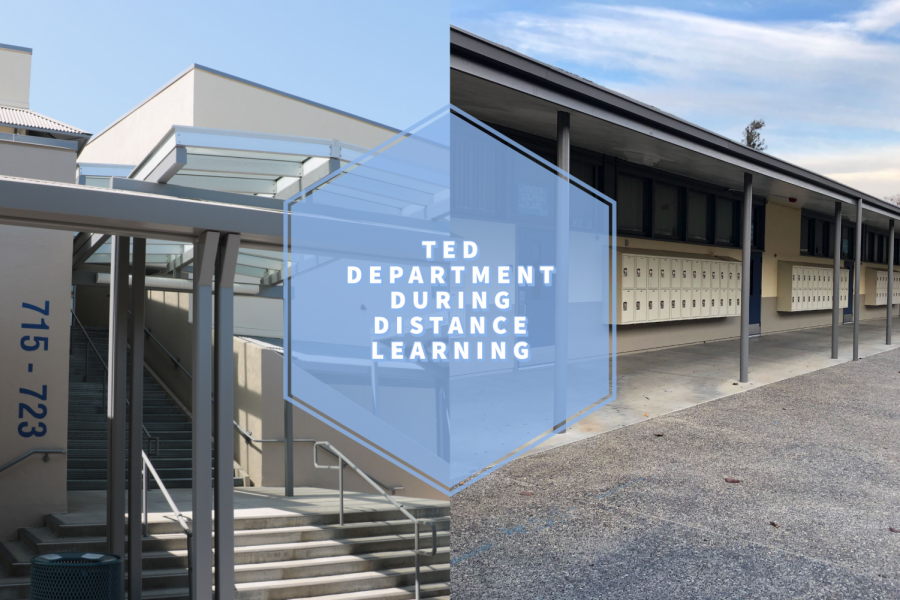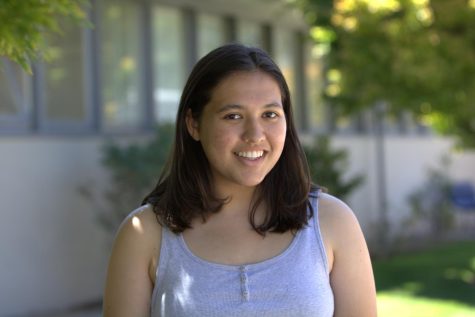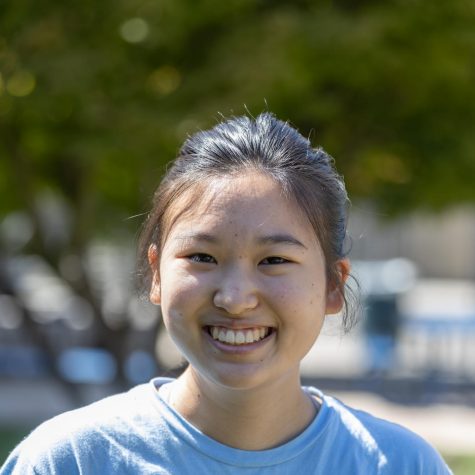Elyssa Kennedy and Navya Singhai
Normally nested in the 700s (left) and 500s (right) wings on campus, Technology, Engineering and Design (TED) courses have acclimated to this school year’s virtual environment with innovative solutions stemming from teachers in the department. These typically hands-on and collaborative classes have been able to transition to a more limited at-home format with curricula focused on developing fundamental skills.
Reinventing TED classes during distance learning
December 7, 2020
Now in a virtual environment, Technology, Engineering and Design (TED) classes typically replete with 3D printers and power saws have adapted their curriculum to ensure that students can thrive in their studies at home. Continue reading to learn more about the TED Department’s innovative solutions to distance learning as teachers push for collaboration, critical thinking and creativity.
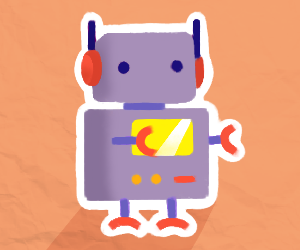
Los Altos High School’s robotics room stands empty as students develop their teamwork and technical skills from behind a computer screen. Despite the lack of a competition this season, students continue to experiment with robot construction and programming in hopes of returning to campus.
Robotics
While Robotics is typically a hands-on experience, Hine has had to come up with new projects and utilize online tools in the first semester of Robotics to ensure students have the necessary skills to compete even in the absence of the usual competitions.
The first semester of Robotics is usually a training period for the FIRST competition which can lead to national championships. During this period, returning members are trained to lead their team, and the new members learn the fundamentals of robotics.
Hine is mimicking this format by sending home small robotics toolkits and assigning problems for the students to solve using the robots. In addition, students are tasked with online videos to watch with the purpose of learning how to use practical shop — the workspace that the robots are built in — skills like safety and basic conduct.
“Our final for Robotics is for the students to research a real-world robot and apply it to what they learned this semester,” Hine said. “It’s a great opportunity because they’re able to dive deeper into the conceptual and more abstract aspects of robotics.”
If permitted, Hine plans on sending a small cohort of Robotics students back to campus so they can continue enhancing their robotics skills and start building both their teamwork and robots together.

Each of the three courses in the Computer Science pathway has endured its share of setbacks because it takes more than a computer to successfully teach and learn the subject and its applications. Intro to Computer Science teacher Jeanne Yu, AP Computer Science teacher Brent Smith and Advanced Data Structures and Embedded Networks (ADEN) teacher Scott Murray have relied on past sources, while discovering new resources to aid students just beginning their computer science education all the way to complex concept extensions.
Computer Science
Introduction to Computer Science
With computer science being such a broad field of study, the Intro to Computer Science course offers students without prior experience a chance to understand the core thinking and fundamentals of computer science before segueing into its more rigorous applications.
The first semester of the course is taught entirely on Snap, a block-based coding language, helping students understand the fundamental thought process of computer scientists without having to worry about the syntax, the written rules of computer languages.
Adapting to the virtual environment, Intro to Computer Science teacher Jeanne Yu now lectures her classes on this content using pre-recorded video lessons and by testing for understanding through hand-written assessments.
“An obvious advantage of having paper assessments is that there’s less cheating, but also coding on paper is an essential skill if a student wants to pursue computer science in the future,” Yu said. “Many job interviews ask you to write code on a whiteboard, which is very different from typing it out because you actually have to think about your steps.”
In previous years, the course was partnered with the Technology Education and Literacy in Schools (TEALS) program, which allowed professionals in the tech industry to volunteer and provide more individualized instruction for students. For instance, if a student was struggling with a concept during the lecture, a TEALS volunteer could always guide them through the material afterward.
Distance learning has made it difficult to partner with the program this year, but that hasn’t stopped many of the TEALS volunteers from virtually returning to help students with coursework on their own time, with no affiliation to the program.
“In the past, the volunteers and the students have developed a connection making students more comfortable when asking for help,” Yu said. “I was worried that that bond wouldn’t carry over given an online format, but as I’m observing throughout this year, the students are getting more comfortable with the volunteers as I don’t need to prompt them anymore to ask the volunteers questions.”
Yu plans to continue pre-recording her lectures and lessons throughout the duration of the pandemic and will continue to improve on her lessons to mirror as much of an in-person experience as possible.
AP Computer Science
On the surface, computer science seems like it would be one of the easiest courses to transfer to an online format because it only requires one tool — a computer. However, AP Computer Science teacher Brent Smith has had to overcome his share of obstacles to ensure the success of his classes, as there’s more to computer science than just access to technology.
Building on the introductory class, AP Computer Science aims to not only properly prepare students for the AP exam but to also explore advanced programming concepts such as working with real data points, which helps students prepare for ADEN, the hardest computer science course offered at LAHS.
Although taking the Intro to Computer Science course isn’t a prerequisite to the AP class, the basic principles of Java covered in the introductory course are included in the AP curriculum to ensure that students have the necessary experience to excel. This addition of material to the original curriculum, however, has increased the pace of the in-person course, leading to the added challenges of compressing the material into two 75-minute sessions a week rather than the former 235 instructional minutes.
“For this class, I can’t just tell students to read the book and expect that everyone will get the material,” Smith said. “There are just so many conceptual things that we have to go over in class, otherwise students may be spending 10 hours working on a problem because we didn’t go over all the examples.”
To deal with this issue, Smith transitioned to an online format by “flipping the classroom,” a concept in which students watch the traditional lecture style videos at home and collaborate or review material in class.
In order to maintain student engagement, Smith has opted for shorter lectures broken up by questions in between videos to ensure that students have retained all the material.
“I’ve been really pleased with the quality of student work,” Smith said. “There are several students who came into the class with less coding experience, but they’ve worked so hard by coming into office hours with the attitude of really wanting to learn. Despite all the challenges, seeing so many students show such a love for learning and initiative to get help has been very encouraging.”
Even after the pandemic, Smith plans to incorporate the library of lecture-style videos he’s created and other virtual resources as supplementary learning materials to augment the in-person learning experience and enrich class time with students.
“Computer science is such a viable career path for many students,” Smith said. “Just because we’re remote, I don’t want any student who’s interested in computer science to be diminished from it at all. I want students to be able to experience the frustrations and magnificence of the subject, even though we’re in the midst of a pandemic.”
ADEN
While any newly introduced class brings challenges regarding pacing, curriculum and projects, the challenges are especially accentuated this year in the Advanced Data Structures and Embedded Networks (ADEN) course which builds off of the AP Computer Science class as it is harder for instructor Scott Murray to gauge the success of his class through a screen.
“In computer science — even more than math, the importance of being able to walk around and see who’s able to code small things and provide instant feedback is huge,” Murray said. “If someone’s having a problem on their computer screen, it’s hard to deal with that remotely because you can’t share your screen one-on-one.”
Despite the challenges, the transition to an online environment has forced Murray to be more creative with his class such as in finding methods to help students debug their projects without having to share their code with the whole class.
Additionally, the small, tight-knit class of 50 students is determined to make the most of their time, growing closer together over Discord and attending classes ready to tackle new concepts head-on.
“If I had known there was going to be a pandemic, I might’ve delayed this class for a year because it’s challenging especially if you don’t have in-person help,” Murray said. “This year, student feedback is really important because it’ll help me get at least somewhat of a sense of what I should do to improve for next year.”
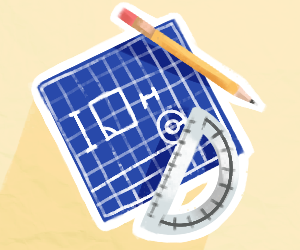
While transitioning to distance learning, accessibility was the primary issue for Intro to Engineering Design teacher Jeanne Yu and Innovative Design Essentials teacher Stephen Hine. Through balancing conceptualization with hands-on experimentation in their updated curricula, Yu and Hine strive to optimize students’ learning experiences.
Engineering & Design
Intro to Engineering Design
As the pandemic carried on to this school year, Yu had to adapt her Intro to Engineering Design class to fit an online format as well. The introductory course explores 3D modeling through online software and teaches students design skills through various independent projects.
Typical assignments include a “workspace improvement project” in which students design an original product to improve the quality of living in others’ workspaces. However, since the 3D modeling software additional projects like these require isn’t accessible through students’ personal computers, Yu has had to slow the curriculum down and film videos explaining concepts the students have to explore through Fusion 360, a newly-introduced, cloud-based 3D modeling software.
Luckily, Project Lead the Way, the organization that designs the Intro to Engineering Design curriculum, was already planning on changing the curriculum to make the resources more accessible through a cloud, and Yu is working with the administration to strengthen the 3D modeling programs and ensure its success in her classes.
Innovative Design Essentials
The Innovative Design Essentials class is the first in the Engineering pathway, teaching students the design process and equipping them with the skills necessary to explore each pathway offered by the Technology and Design Department.
Typically, students would develop their design thinking skills through experimentation with the 3D printers and laser cutters at school. This year during virtual learning, Robotics and Innovative Design Essentials teacher Stephen Hine was able to mirror that experience by having students design projects online and 3D printing them at school.
“Currently, we’re having our students construct holiday signs,” Hine said. “We sent home kits with lights and other materials, which helps them see their work in real life.”
Despite the disadvantages of distance learning, Hine said that remote instruction has forced the department to think carefully about projects and restructure them so that they are the most conducive to students’ learning.
“We’ve created projects that we plan on using in future years,” Hine said. “We’ve developed ways that we can teach students the material more effectively which is a huge positive.”

